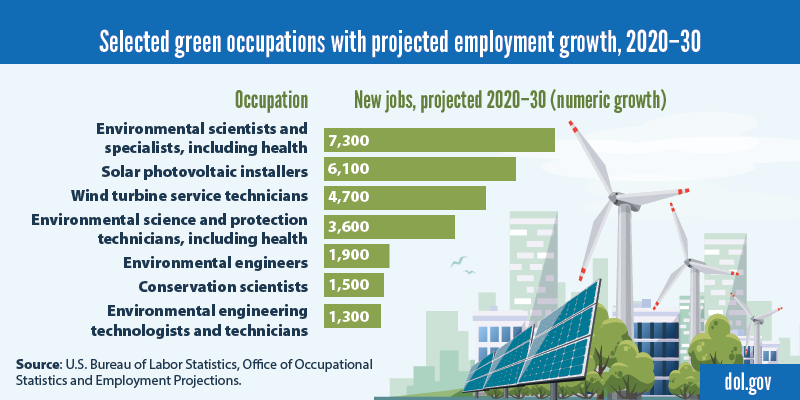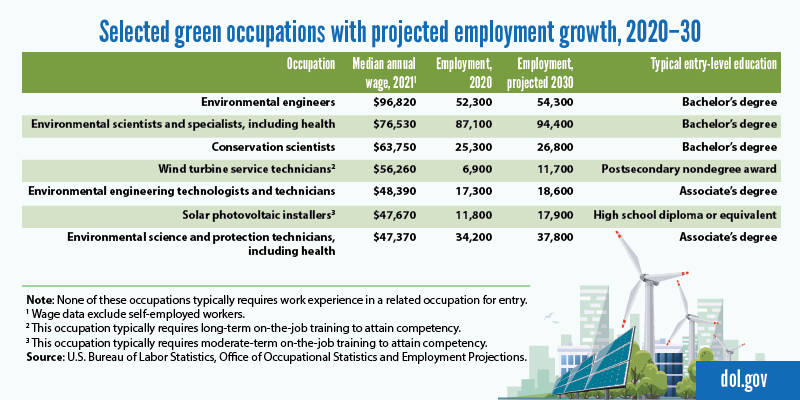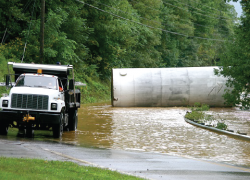If your career plan involves caring for the planet, there’s good news. The U.S. Bureau of Labor Statistics projects job growth in many occupations related to helping the environment or conserving natural resources.
In fact, two of the occupations that BLS projects to have the fastest employment growth from 2020 to 2030, wind turbine service technicians (68% increase) and solar photovoltaic installers (52% increase), involve “green” work. However, as the data show, the total number of new jobs is projected to be relatively small in these and some other green occupations.

Each of these occupations had a median annual wage that was higher than the $45,760 median for all workers in 2021. The typical education required to enter these occupations varies.
Workers in green occupations focus on the environment in different ways. Wind turbine service technicians and solar photovoltaic installers, for example, build and maintain systems that create energy from sources that don’t become depleted. Other workers help to monitor the environment and investigate sources of pollution. Still others advise organizations or individuals on ways to protect and preserve natural resources.

You can find information about these and hundreds of other occupations in the BLS Occupational Outlook Handbook, which describes what workers do, how to enter the occupation, what the projected job outlook is and more. Check it out and start charting the path to a green job future today.
|
Selected green occupations with projected employment growth, 2020–30 |
|
|
Occupation |
New jobs, projected 2020–30 (numeric growth) |
|
Environmental scientists and specialists, including health |
7,300 |
|
Solar photovoltaic installers |
6,100 |
|
Wind turbine service technicians |
4,700 |
|
Environmental science and protection technicians, including health |
3,600 |
|
Environmental engineers |
1,900 |
|
Conservation scientists |
1,500 |
|
Environmental engineering technologists and technicians |
1,300 |
|
Source: U.S. Bureau of Labor Statistics, Office of Occupational Statistics and Employment Projections. |
|
|
Selected green occupations with projected employment growth, 2020–30 |
||||
|
Occupation |
Median annual wage, 20211 |
Employment, 2020 |
Employment, projected 2030 |
Typical entry-level education |
|
Environmental engineers |
$96,820 |
52,300 |
54,300 |
Bachelor's degree |
|
Environmental scientists and specialists, including health |
$76,530 |
87,100 |
94,400 |
Bachelor's degree |
|
Conservation scientists |
$63,750 |
25,300 |
26,800 |
Bachelor's degree |
|
Wind turbine service technicians2 |
$56,260 |
6,900 |
11,700 |
Postsecondary nondegree award |
|
Environmental engineering technologists and technicians |
$48,390 |
17,300 |
18,600 |
Associate's degree |
|
Solar photovoltaic installers3 |
$47,670 |
11,800 |
17,900 |
High school diploma or equivalent |
|
Environmental science and protection technicians, including health |
$47,370 |
34,200 |
37,800 |
Associate's degree |
|
Note: None of these occupations typically requires work experience in a related occupation for entry. |
||||
|
1 Wage data exclude self-employed workers. |
||||
|
2 This occupation typically requires long-term on-the-job training to attain competency. |
||||
|
3 This occupation typically requires moderate-term on-the-job training to attain competency. |
||||
|
Source: U.S. Bureau of Labor Statistics, Office of Occupational Statistics and Employment Projections. |
||||

 U.S. Department of Labor Blog
U.S. Department of Labor Blog




